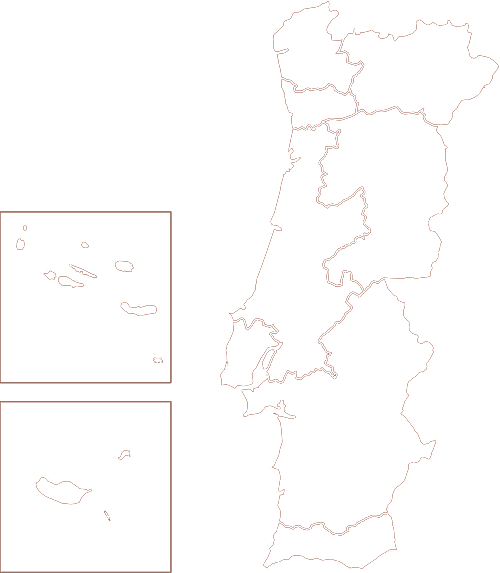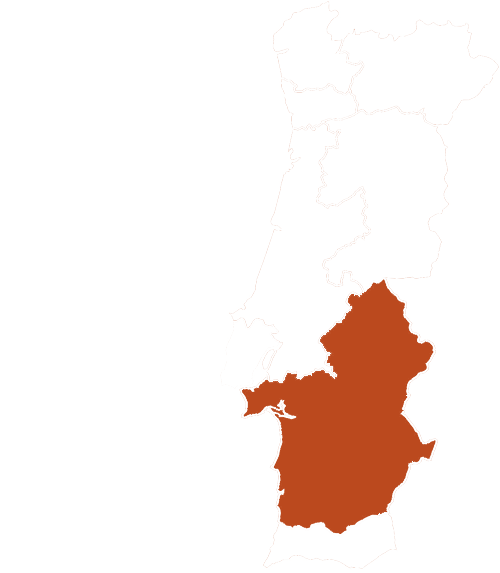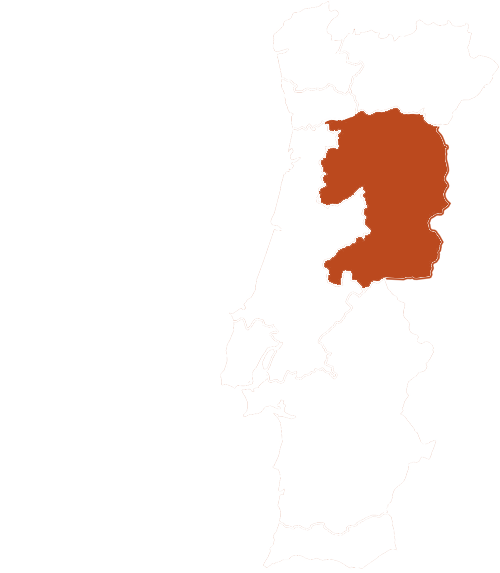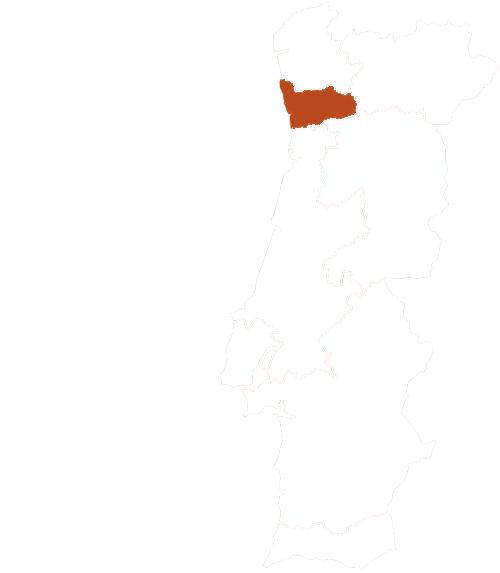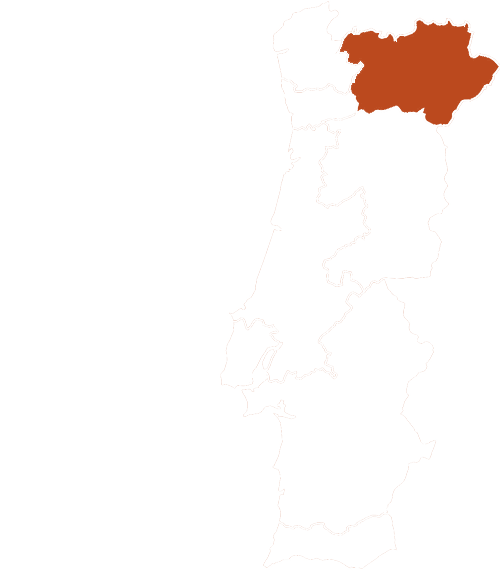Welcome to Lisbon!
Upon arrival at Lisbon airport, reception by TravelTailors guide and delivery of all the documents you will need for your trip to Portugal!
As this is your first day in Portugal, we suggest you have a free afternoon to relax after a long flight, or a stroll around the historic center taking the very typical Hills Trams Tour. It will take you through some of the most interesting streets with an audio-guide to add some extra information on your tour. Wind your way through the hills of Lisbon and discover its most historic quarters, where people chat from their window ledges and clothes hang out to dry in the sun. The contrasts in this richly diverse city will amaze you. From the simplicity of the traditional quarters of Alfama, Castelo and Bairro Alto, to the sophistication of Lapa. The "Yellow" tram as it is affectionately dubbed by the inhabitants of Lisbon, is part of a set of vehicles originally imported from the United States in 1901 with the aim of replacing the old horse-drawn carriages, which were the main means of transportation at that time.
Accommodation in one of our suggested Luxury, Premium or Boutique Hotels.
Full-day private guided tour in Lisbon
Today you will have a full-day guided tour in Lisbon. You will enjoy every moment, drink in all the important historical aspects and have a delicious lunch with the best fresh ingredients!
Lisbon is one of the most fascinating cities in Europe! With blue skies almost all year round and a mild winter, Lisbon offers breathtaking panoramas of the city and the river, a picturesque setting, where old trams take us from the narrow cobbled streets up to the excellent new hotels in broad boulevards, with fabulous shopping opportunities of famous stylists and brands and a fantastic nightlife. The antique blends with the sophistication of the 21st century. Alfama and the Castle invite you on a historic trip to the Arab and medieval times.
In Belém, you will find the majestic Mosteiro dos Jerónimos (Jerónimos Monastery), the famous Torre de Belém (Tower of Belém), the Centro Cultural de Belém (Cultural Centre of Belém) and the many museums that surround them. It is imperative to taste the delicious Pastéis de Belém!
The Castelo de São Jorge in Lisbon is one of Lisbon’s most distinctive monuments, being situated on the city’s highest hill. The oldest known fortification at this spot dates from the 2nd century BC, although some of the remains found here date from as far back as the 6th century BC. Archaeological evidence has also made it possible to discover traces of the presence of Phoenicians, Greeks, Carthaginians, Romans, and Muslims, confirming the human occupation of this area since very remote times. The castle itself was founded in the 10th and 11th centuries when Lisbon was an important Moorish port. In 1147, the first king of Portugal, Dom Afonso Henriques, captured both the castle and the city from the Moors. The castle enjoyed its most important period between the 13th and 14th centuries. It was also here, in the 16th century, that King Dom Manuel I received Vasco da Gama after his sea voyage to India and that the first Portuguese theatre play, written by Gil Vicente, was performed to mark the birth of the king Dom João III.
VIP Experience – Get to know an experienced swordsman with extensive training in Medieval sword fighting, a real tutor of medieval fencing! This swordsman will provide you a private lesson on how to fight using some of the most used swords and weapons in the middle ages in Portugal.
After this first day in Lisbon, your private driver will take you back to your hotel.
Accommodation in one of our suggested Luxury, Premium or Boutique Hotels.
Full-day privately guided tour to Sintra and VIP Experience “Medieval Archery”
Today after breakfast, your guide will pick you at the hotel for a full-day tour in Sintra. Before heading out, you’ll have the opportunity to have another VIP Experience.
VIP Experience – Practise Medieval Archery in Lisbon. Enjoy a private lesson in Lisbon with an experienced tutor archer, who will introduce you to one of the most used medieval bows in Portugal, the “Horsebow” and the “longbow”. This experience requires strength, concentration and skill. If you’re interested in this VIP experience please let us know if you fill the requirements. arqueirosmedievaisdelisboa@gmail.com
Continue with a full-day guided tour to Sintra. A romantic region, with many charms, and the homeland of the delicious sweet queijadas (made with cheese or curd cheese, eggs, milk and sugar) and travesseiros de Sintra (a cake filled with sweet egg yolk and an almond touch). Monuments, sea, and mountains get together in one of the most perfect combinations. The Serra de Sintra (Sintra Mountain) starts right in the center of the village and ends at the ocean, at the most western point of mainland Europe, Cabo da Roca. Declared World Heritage by UNESCO, Sintra was often chosen by the aristocracy to install their palaces and mansions. Visit the beautiful Palácio da Pena (Pena Palace), and the Castelo dos Mouros (Moorish Castle), dating back to the early days of the Moorish occupation of the Peninsula - the 8th Century. After various attempts, it was definitively taken by Dom Afonso Henriques in 1147, and the first Christian Chapel was then built.
In the romantic period, about 1860, the walls were restored under the supervision of Dom Fernando II, husband of Dona Maria II, who afforested the surrounding areas, and gave the old medieval ruins a new dignity. Of note is the Moorish Cistern in the interior, and the so-called Royal Tower.
It is possible to enjoy a lovely mountain hike around the castle walls.
Accommodation in one of our suggested Luxury, Premium or Boutique Hotels.
Full-day private guided tour in the Alentejo
Today, head to the region of Alentejo, considered by the Traveler Magazine as one of the best spots to visit.
Your first stop is Palmela. A small town, located in one of the hills of the Arrábida mountain range, which has over the centuries attracted the various military forces who have passed through the Iberian Peninsula. It is believed to owe its name to the Romans, specifically to a praetor called Palma. The Moorish were responsible for building the castle at its highest point, from where it dominates the whole area between the Sado and Tagus Rivers, and even the Sintra mountain range can be seen.
This explains its importance during that period for reasons of military strategy, just as nowadays it is one of the best belvederes in the entire district.
Continue to Evora, one of the most emblematic Portuguese cities. Its beautiful historic center has been classified as a UNESCO World Heritage Site.
A very local and central attraction is the famous Praça do Giraldo, with Arabian-style arches and a fountain dating from 1571, a meeting place for all generations, with animation and special performances. One of the main treasures in this city is the Templo Romano de Évora (Roman Temple of Évora), also called Templo de Diana. It’s a temple of Corinthian style, built in the early I century AD. It is what remains of the forum of the city of Évora and was dedicated to the imperial cult, contrary to what comes to us by popular tradition, which identified it as being dedicated to Diana, the Roman goddess of hunting. The temple, built in marble and granite, is surrounded by Corinthian columns placed on a podium which is almost complete. Places you must visit are the imposing Cathedral, built between 1186 and 1204, the Igreja de São Francisco (Church of São Francisco), the famous Capela dos Ossos (Chapel of Bones), the beautiful Igreja dos Loios (Lóios' Church) (15th century), and the Palácio de Dom Manuel (Palace of D. Manuel). Nearly 20 churches and monasteries of the city denote their religious and historical significance.
Just a few minutes driving up north you will find Estremoz. Once again, marble and whitewashed houses, which bring freshness to very warm days, emerge from the immense landscape of olive groves and vineyards. Once the home of Roman and Muslims, a house of many kings and queens of Portugal, Estremoz has a rich heritage, both from the cultural and archaeological point of view. Two sets of medieval walls surround the town: the first set dates from the thirteenth century and lies around the "old town"; the second corresponds to the fence of fortified walls erected to defend the downtown of Estremoz during the war for the restoration of the Portuguese independence from Spain (17th century). From the old town by the castle, you can enjoy a peaceful and bucolic view of the Alentejo countryside.
It´s impossible not to mention the simple but creative gastronomy of Alentejo. The cuisine is an authentic experience coming from the hands of the hardworking and friendly people who work the land of the region, from the olive trees to the vineyards to the animals in the fields. There are many traditional restaurants, in a laid-back and cozy environment where you will find very good examples of this gastronomy. Indulge yourself!
Accommodation in one of our suggested Luxury, Premium or Boutique Hotels.
Full-day private guided tour in the northern Alentejo region
Today you’ll visit the northern region of Alentejo, and its most impressive castles of Flor da Rosa and Marvão, which were of great importance to the defensive lines of Portugal against Castille (Spain).
In the morning, visit the magnificent Castle of Flor da Rosa. This hospital monastery is one of the most important national Gothic monuments and was already considered the "most important Portuguese church-fortress". It has an immense symbolic background since it was designed as a church, monastery, and palace. The construction began around 1340 by the orders of the grand-prior of the Hospital, Álvaro Gonçalves Pereira. The church is the most important piece. The temple features a Greek cross, imposed by its verticality, which is underlined by the robustness and massive walls. Nowadays this castle is a luxury hotel, with its grand hall serving as a restaurant.
Continue uphill towards the hilltop castle of Marvão, located at the most extreme eastern border of Portugal, on the highest crest of the Serra de São Mamede. Geographically, Marvão is a point of natural strategic defense, marked by steep slopes to the north, south, and west. Inside the walls are narrow streets lined with the beautiful popular houses that are typical of the Alentejo. Amidst them, it is easy to find Gothic arches, Manueline windows, wrought-iron balconies and other embellishments in the nooks and crannies of the buildings made from the local granite. This impressive fortress town served as an entry point to the thousands of Jews who fled Spain in the 15th and 14th centuries.
Accommodation in one of our suggested Luxury, Premium or Boutique Hotels.
Full-day tour to the Castles of Sortelha, Idanha-a-Velha and Monsanto.
Today you will begin your visit with Sortelha. Surmounted by a 12th-century castle, the Templar Knights of Sortelha built here a formidable crag at an altitude of 760 meters. Sortelha still keeps its medieval appearance intact through the architecture of its rural granite houses. The village name derives from the nature of its terrain, being surrounded by rocky escarpments in the shape of a ring (sortija, in Castilian), its walls also having been built in a circular shape.
The great charm of this village is its evocation of a medieval atmosphere, with all the houses having been built of granite and comprising just one floor. All around Sortelha, the landscape has the rugged beauty of the large granite boulders and the chestnut groves that frequently accompany these.
Continuing to Idanha-a-Velha and enjoy lunch in one of the traditional restaurants.
The Castle of Idanha-a-Velha has a most valuable historical heritage. Its past traces the village to the Roman period as a prosperous Roman town of Civitas Igaeditanorum, which was on the great Iberian road linking Emerita (Mérida) to Braccara (Braga). During the Muslim period, then named as Idânia (8-12th century) it grew to be a large and prosperous city, almost as rich as Lisbon.
By the 12th century, a time of crusades, as a consequence of battles between Christians and Muslims, our first king Afonso Henriques, as part of the brotherhood gave the city to his fellow companions the Order of the Knights Templar in order for it to be repopulated.
End your day with majestic sunset at the Castle of Monsanto!
In 1938, Monsanto was voted as the most typical village of Portugal, deserving this title: perched on a granite hill, the houses are squeezed between huge boulders, with tiny backyards and gardens separated by walls of stone and slopes carved into the rock. The castle began as a Lusitanian fort, later restored by the Romans, suffering a long history of sieges and battles. Everything in the village has been carefully preserved. The difficult climb to the castle is largely compensated by one of the most breath-taking views in the region.
Accommodation in one of our suggested Luxury, Premium or Boutique Hotels.
Full-day tour to the hilltop castles of Trancoso, Marialva, and Penedono.
Due to its splendid location on inaccessible cliffs and the left bank of the river Alva, the small village of Marialva was also a place of military importance. A village of ancient roots, it was already inhabited in the VI century BC, by the tribe of Aravis. It was occupied successively by the Romans (who gave it the name Civitas Aravorum), by Swabians and Arabs who settled in its defensive fort. It is also told that the king of Portugal, D. Afonso II, had donated the village in 1217 to one of his lovers, D. Maria Alva, who is the origin of the name of the village. The castle was rebuilt by King Sancho II of Portugal, around the year 1200, over the ruins of the Romanized fort. It is one of the largest in the region, now offering a magnificent panorama over Serra da Marofa (Marofa Mountain) and the surrounding region. Sidewalks lined with medieval walls and gothic doors lead to a small square where there is an elegant pillory all made of granite, from the 15th century, as well as the old jail and courthouse.
Continue to the town of Trancoso, a walled village dating back to the 10th century. Once an outstanding fortress with 15 towers, eleven of those are still standing to the present day with four main gates. In 1159, the royal charter was given by the first King of Portugal and the castle was then donated to the Order of the Temple. It was at the time that a defensive wall was built around the early Mozarabic tower, turning it into a keep.
At last the unique Castle of Penedono, standing on a huge rock about 900m high, a unique example of military architecture that dominates the surrounding countryside. Small but extremely gracious, set off by elegant towers topped off with battlements, the Penedono castle does not seem like any mere, basic defensive structure. Its documented history stretches back to a testament made in the tenth century. The castle was home to the noble Coutinho family. During the Portuguese dynastic struggles of 1383-85, they backed the party of King João, Master of Avis, king of Portugal in 1385, after the defeat of Castile at Aljubarrota. Gonçalo Vasques Coutinho was later lord of the castle and his children were born here, including Álvaro Gonçalves Coutinho, known as Magriço, a knight who carried out romantic feats and won a tournament in the English Royal Court.
The current castle structure dates back to a fifteenth-century reconstruction coinciding with the royal charter granted to the town of Penedono by King Manuel I in 1515.
Hopefully your visit includes a sunny late afternoon. The sunset here is a truly special moment!
Accommodation in one of our suggested Luxury, Premium or Boutique Hotels.
Full-day private guided visit to the elegant Wine Estate of Quinta da Ervamoira
This will be a more relaxing and easy-going day! After all, knights and kings also had their day-off! After an invigorating breakfast, leave this mountainous region of medieval castles for the renowned wine region of the Douro Valley.
En route, have a private guided visit to the elegant Wine Estate of Quinta da Ervamoira, including a premium wine tasting with a fantastic lunch and a panoramic view.
The Quinta de Ervamoira is located in the Douro region, sub-region of the Douro Superior, in the area of Vila Nova de Foz Côa. With a total surface area of 234 hectares and with altitudes which vary between 110 and 340 meters, this quinta has 150 ha of vineyards with an average age of 30 years old. In Ervamoira, the vertical form of planting has been exclusively used. Only 10% of the varieties produced there are white. Of the remaining 90%, 32% of Touriga Nacional, 22% of Touriga Franca, 11% of Tinta Roriz, 7% of Tinta Barroca, 7% of Tinta da Barca and 21% others.
In 1974, José António Ramos Pinto Rosas, then the Chairman of Casa Ramos Pinto, was persistently looking for an estate on fairly flat land that would allow for mechanization, as already at that time the lack of and the high cost of labor was being felt in the Douro. Having studied military maps, he found and bought the Quinta de Santa Maria, re-christened as Quinta de Ervamoira, which would become a model estate in the entire Douro region.
The five best varieties were then selected and the aim to produce not only Port Wine but also Still Wine. Respecting a tradition as old as its own history, Casa Ramos Pinto continued to give importance to the cultural aspects of the history of the Quinta de Ervamoira. It invested in the creation of an on-site museum for the public which was inaugurated in 1997 by the then Minister of Culture, Prof. Doctor Manuel Maria Carrilho. With the decision taken by UNESCO to give the Vale do Côa the status as World Heritage Site, the Quinta de Ervamoira was given the privilege of becoming the first wine-producing estate to use such a title.
Continue driving towards the heart of the Douro Valley. Free afternoon to enjoy the hotel amenities and SPA.
Accommodation in one of our suggested Luxury, Premium or Boutique Hotels.
Full-day tour in the Northern Region of Minho, visiting Guimarães and Barcelos, and finishing in Porto.
Visit the Cradle of Portugal - Guimarães. Guimarães is considered the birthplace of Portugal because Afonso Henriques, who came to be the first king of Portugal, was born here.
The historical center in the area that was within the Guimarães city walls, is associated with the formation and identity of Portugal and was classified a World Heritage site based on the originality and authenticity applied in its restoration. The city still has a harmonious, well-preserved heritage that is evident in the graceful iron verandas, granite balconies, and porticos, mansions, arches connecting the narrow streets, paving slabs smoothed by time, towers and cloisters. For a moment, you might imagine yourself to be in a medieval setting where the nobility built their houses over time.
You can start your visit from the old Castle on the top of the highest hill of Guimarães. Here, you also can visit the Dukes of Bragança Palace built in the first half of the 15th century. This Palace stands out for its well-known "Pastrana tapestries", portraying important events related to the maritime discoveries of the 15th century, such as its porcelain collection from the India Company, Portuguese ceramics, the Flemish tapestries, amongst many other valuable pieces. Then, walking through the narrow streets of the historical center, you’ll come to the beautiful square of Oliveira (classified as a Heritage Cultural UNESCO site) and you’ll be tempted to stop for a cup of coffee in one of its street cafes.
At the square of Largo da Oliveira, you'll find the monument Padrão do Salado and the Collegiate Church of Nossa Senhora da Oliveira, which houses the valuable Alberto Sampaio Museum. Passing the City Hall, crowned with battlements, enter the Praça de Santiago which in the Middle Ages welcomed pilgrims bound for Compostela, just as today it welcomes residents and tourists in its restaurants and terraces.
For another view of the city, you can go up in the cable car to Monte da Penha, to enjoy one of the most beautiful panoramas in northern Portugal, where you will find the Shrine of Our Lady of Penha.
As you continue on your journey and cross the old bridge over the River Cávado, you will arrive at one of the most emblematic cities of popular Minho art, Barcelos. A famous town in Portugal, for its brave Knights and for the eternal legend of the Cockerel of Barcelos, which became the national symbol of Portugal.
This city was of great importance in the middle ages as the lords of Barcelos were given the eternal title of Counts. Always loyal and brave lineage which was proud to be in the front-line of every battle. One of its famous lords was, Nuno Álvares Pereira, 7th Count of Barcelos. He then gave Barcelos as a dowry in the marriage of his daughter D. Beatriz to D. Afonso, the bastard son of D. João I. There then followed a period of great development and dynamic growth for Barcelos, displayed by the building of the bridge, the city walls, of which there still remains the Torre da Porta Nova, the Paço dos Duques and the Igreja Matriz.
Today the city still retains a pleasant medieval atmosphere and amidst which are scattered manor houses and other historic residences, such as the Solar dos Pinheiros or the Constable´s House.
A stroll around Barcelos must necessarily include the old fairground. Now known as the Campo da República, where you will find the 18th-century churches of Bom Jesus da Cruz and Nossa Senhora do Terço and where Portugal's largest handicraft fair is held every Thursday.
Accommodation in one of our suggested Luxury, Premium or Boutique Hotels.
Half-day guided tour in Porto
After breakfast, your guide will pick you up at the hotel for a half-day tour in Porto followed by a visit to a Wine Cellar.
Your visit will start with Porto's Baixa (Downtown) which is laid out around the Avenida dos Aliados (Avenue of the Allies), the city´s focal point. At the top of this thoroughfare, there is the imposing Municipal Council building. At the other end, it opens onto the Praça da Liberdade (Liberty Square) where there is a statue of a mounted Pedro IV (19th c.), emperor of Brazil and, like much of Porto, a supporter of the Liberalism movement. In a show of recognition, the king literally gave his heart to the city, now watched over in the Church of Lapa.
Heading up Rua de São Filipe Néry, there is the Church and Tower dos Clérigos (Ecclesiastics), the centerpiece of the city and the most original design by Nicolau Nasoni. From 75 meters up in the tower, there is a wonderful panoramic view over the city of Porto and beyond. On the way, take a look into the Lello bookshop and admire the lavish decoration. Known all over the world, among other reasons, for its staircases that inspired the author of Harry Potter, Lello is considered one of the best and most beautiful bookshops in the world.
Surrounding this center, there is a dense network of streets packed with stores and cafes. Of the latter, the magnificent Majestic and the cheerfully bustling Mercado do Bolhão are well worth a visit. On the streets 31 de Janeiro, Galeria de Paris and Cândido dos Reis check out the facades with their Art Nouveau finishing’s.
To the side of the square, look at the São Bento (Saint Benedict) railway station to see the pictured tiles in the entrance hall. Then head down the Rua das Flores (Street of Flowers), with its goldsmiths and the exuberant baroque façade of the Church of Misericórdia (Compassion), a masterpiece by architect Nicolau Nasoni.
Just a little bit uphill, you'll find the Cathedral. Besides the church, which was started in the 12th century, it is worth visiting the tile-covered cloisters. The precinct, with its pillory and other monuments, has a superb view over the river and the houses on both sides.
Continue downhill towards the riverfront - Ribeira - This is one of the most attractive districts of Porto, in which you get a feel for the ancient vernacular ambience. You can start a cruise on the Douro from here. In this area, you will find two of the most important monuments. First the Church of S. Francisco, the most important Gothic church in the city, whose Baroque interior is completely covered in gilt carvings. And just attached to it, you'll find the Palácio da Bolsa (Stock Exchange). A beautiful 19th century building, whose highlights include the famous Salão Árabe (Arab Hall), the Hall of Nations and a remarkable grand staircase.
Visit to a Port Wine Cellar
You will have the chance to visit a Port wine cellar and taste some of this deliciously sweet dessert wine. Port wine is a fortified wine and naturally produced exclusively using grapes from the Douro demarcated region, in the north of Portugal about 100km east of Porto. The wine took the name of Porto, but its cellars are located on the opposite bank of the Douro River, in Gaia. The cellars are long cool, dark warehouses, their thick granite walls and high ceilings helping to keep out the heat and maintain an even temperature throughout the year.
This ensures that the wines age slowly, gradually acquiring the sublime complex flavors and aromas of maturity. While Port matures in wood, a small proportion is lost each year to evaporation. The part which evaporates – commonly known as the ‘angel’s share’ – is composed of moisture and spirit. As a result, the aromatic components which remain in the wine gradually become more concentrated as it ages. The evaporation of the spirit causes the development of the black ’Angel’s share fungus’, Baudoinia compniacensis, on the roof tiles of the lodges, making it easy to see from the air where the wine is stored.
Your cellar visit includes tasting different varieties of this delicious wine.
Night River Cruise along the Douro River with dinner on-board
Precisely during sunset, embark on a private boat trip where you will “float” along the Douro River! More than just having a privileged view you will have the insight perspective of the architecture and engineer of the bridges that link the two amazing cities and the charming atmosphere created by the lights which illuminate the buildings and streets at nightfall!
Accommodation in one of our suggested Luxury, Premium or Boutique Hotels.
Today, after breakfast, head back to the center of Portugal, stopping in the World Heritage Site of Coimbra, where you will meet your local guide and together discover the historic center and all the stories that this historic city preserves.
Half-day guided tour of Coimbra.
Coimbra is an academic town full of culture, history, and beauty. Its history dates to Roman times. It was the scene of a dramatic love story: the forbidden love between the future king, Dom Pedro I, and a Galician lady, Inês de Castro, who was executed by order of King Afonso IV, who saw the danger in this love of a subjugation to Castile. Inspiring poets and writers, this historical occurrence remains part of the city's heritage. Overlooking the city, the Monastery of Santa Clara-a-Velha is considered the most important monument for the study of the Gothic style, in Portugal. Today it is best known for its beautiful architecture and wonderful regional cuisine, as well as its famous university. This city of students is known for its centuries-old university, the University of Coimbra, which is one of the oldest in Europe, founded in 1290 in Lisbon and then transferred to Coimbra in 1537. Visit the most prominent monuments of the city, including the Joanina Library, and the Old Cathedral. The Museum Machado Castro, next to the University, is also very much worth a visit.
End the day in the Castle of Óbidos, one of the most beautiful and unspoiled villages of Portugal. It is strongly linked to the nobility since the thirteenth century when King Dinis married Isabel of Aragon. Among many gifts, the monarch gave to his wife the village of Óbidos.
Walk through typical streets of the romantic medieval town, climb the wall that surrounds the village and enjoy the view over the houses. The old buildings are home to everything a traveler needs for a pleasurable visit: there are good restaurants, a collection of craft shops and art galleries full of charm, plus many cellars - among local specialties and wines, you will find ginjinha, a kind of liquor made from a type of wild cherry, tiny and very tasty, abundant in the region. You cannot leave without trying “ginjinha” in a chocolate cup which you can and should eat after drinking the liquor!
Accommodation in one of our suggested Luxury, Premium or Boutique Hotels.
Full day tour to the Knights Templar Region.
Start off with the Monastery of Batalha, or Santa Maria da Vitória, a true masterpiece of the Portuguese Gothic period, a magnificent piece of architecture that combines various influences from its lengthy period of construction, which lasted several reigns. It was constructed in 1386 to keep a vow by Portuguese King Dom João I to Virgin Mary that he would build it if Portugal would defeat Castile at the Battle of Aljubarrota on 14th August 1385. Extravagant celebrations commemorating this victory are held next to the monastery in August of every year. Outstanding in the interior are the Founders' Chapel with its fine stained-glass windows, the cloisters, the Unfinished Chapels with their Manueline and Flemish Gothic features and the Chapter House.
The former seat of the Order of the Knights Templar, Tomar is a city of great charm for its artistic and cultural wealth, whose greatest expression is in the Convent of Christ, one of the very best examples of the Portuguese Renaissance period. The development of Tomar is closely linked to the Order of the Templars, which received these lands in 1159 as a reward for the assistance they gave to King Afonso Henriques in the Christian reconquest of the territory.
It was Dom Gualdim Pais, the first Grand Master of the Order in Portugal, who founded the castle and the remarkable Convent of Christ. Enlarged and modified over the centuries, this retains the influences of various architectural styles.
The Order of the Templars was suppressed in France in the early 14th century, but in Portugal, it was transformed into the Order of Christ as an initiative of King Dom Dinis. This was subsequently approved by the Pope, and it was decided that the immense wealth they possessed should pass to the Order of Christ, which came to play an important part in the historic Portuguese Discoveries.
End this thematic itinerary in the fairy-tale Castle of Almourol. One of the most emblematic and enigmatic monuments of the Christian reconquest of the 12th century. Almourol Castle is also one of the most significant military Medieval monuments, which best evokes the memory of the Knights Templar in Portugal.
Its history reminds us of the Reconquest of the Portuguese territory during the Middle Ages. When the Christians arrived here in 1129, the castle already existed under the name of Almorolan, having been incorporated immediately afterwards into the land that was placed under the protection of the Knights Templar, whose Master at that time was Gualdim Pais. According to an inscription at the entrance to the castle, its reconstruction began in 1171.
Accommodation in one of our suggested Luxury, Premium or Boutique Hotels.
Hotel check-out and private transfer to the airport.





